Hibiscus
| Hibiscus | |
|---|---|
 | |
| Hibiscus rosa-sinensis | |
| Scientific classification | |
| Kingdom: | Plantae |
| (unranked): | Angiosperms |
| (unranked): | Eudicots |
| (unranked): | Rosids |
| Order: | Malvales |
| Family: | Malvaceae |
| Subfamily: | Malvoideae |
| Tribe: | Hibisceae |
| Genus: | Hibiscus L. |
| Species | |
| Synonyms | |
|
Bombycidendron Zoll. & Moritzi | |
Hibiscus (/hɨˈbɪskəs/[2] or /haɪˈbɪskəs/[3]) is a genus of flowering plants in the mallow family, Malvaceae. It is quite large, containing several hundred species that are native to warm-temperate, subtropical and tropical regions throughout the world. Member species are often noted for their showy flowers and are commonly known simply as hibiscus, or less widely known as rose mallow. The genus includes both annual and perennial herbaceous plants, as well as woody shrubs and small trees. The generic name is derived from the Greek word ἱβίσκος (hibískos), which was the name Pedanius Dioscorides (ca. 40–90) gave to Althaea officinalis.[4]
Description
The leaves are alternate, ovate to lanceolate, often with a toothed or lobed margin. The flowers are large, conspicuous, trumpet-shaped, with five or more petals, color from white to pink, red, orange, purple or yellow, and from 4–18 cm broad. Flower color in certain species, such as H. mutabilis and H. tiliaceus, changes with age.[5] The fruit is a dry five-lobed capsule, containing several seeds in each lobe, which are released when the capsule dehisces (splits open) at maturity. It is of red and white colours. It is an example of complete flowers.
Uses

_in_Hyderabad%2C_AP_W_IMG_9075.jpg)

Symbolism and culture
Hibiscus species represent nations: Hibiscus syriacus is the national flower of South Korea, and Hibiscus rosa-sinensis is the national flower of Malaysia. The hibiscus is the national flower of Haiti. The red hibiscus is the flower of the Hindu goddess Kali, and appears frequently in depictions of her in the art of Bengal, India, often with the goddess and the flower merging in form. The hibiscus is used as an offering to goddess Kali and Lord Ganesha in Hindu worship.
In the Philippines, the gumamela (local name for hibiscus) is used by children as part of a bubble-making pastime. The flowers and leaves are crushed until the sticky juices come out. Hollow papaya stalks are then dipped into this and used as straws for blowing bubbles.
The hibiscus flower is traditionally worn by Tahitian and Hawaiian girls. If the flower is worn behind the left ear, the woman is married or in a relationship. If the flower is worn on the right, she is single or openly available for a relationship. The hibiscus is Hawaii's state flower.
Nigerian author Chimamanda Ngozi Adichie named her first novel Purple Hibiscus after the delicate flower.
The bark of the hibiscus contains strong bast fibres that can be obtained by letting the stripped bark set in the sea to let the organic material rot away.
Landscaping
Many species are grown for their showy flowers or used as landscape shrubs, and are used to attract butterflies, bees, and hummingbirds.[6]
Paper
One species of Hibiscus, known as kenaf (Hibiscus cannabinus), is extensively used in paper-making.
Beverage
The tea made of hibiscus flowers is known by many names in many countries around the world and is served both hot and cold. The beverage is well known for its color, tanginess and flavor.
It is known as bissap in West Africa, "Gul e Khatmi" in Urdu & Persian, agua de jamaica in Mexico and Honduras (the flower being flor de jamaica) and gudhal (गुड़हल) in India. Some refer to it as roselle, a common name for the hibiscus flower. In Jamaica, Trinidad and many other islands in the Caribbean, the drink is known as sorrel (Hibiscus sabdariffa; not to be confused with Rumex acetosa, a species sharing the common name sorrel). In Ghana, the drink is known as soobolo in one of the local languages.
Roselle is typically boiled in an enamel-coated large stock pot as most West Indians believe the metal from aluminum, steel or copper pots will destroy the natural minerals and vitamins.
In Cambodia, a cold beverage can be prepared by first steeping the petals in hot water until the colors are leached from the petals, then adding lime juice (which turns the beverage from dark brown/red to a bright red), sweeteners (sugar/honey) and finally cold water/ice cubes.
In Egypt, Sudan and the Arab world, hibiscus tea is known as karkadé (كركديه), and is served as both a hot and a cold drink.
Food
Dried hibiscus is edible, and it is often a delicacy in Mexico. It can also be candied and used as a garnish.[7]
The roselle (Hibiscus sabdariffa) is used as a vegetable. The species Hibiscus suratensis Linn synonymous to Hibiscus aculeatus G. Don is noted in Visayas Philippines being a souring ingredient for almost all local vegetables and menus. Known as Labog in the Visayan area, (or Labuag/Sapinit in Tagalog), the species is a very good ingredient in cooking native chicken soup. Certain species of hibiscus are also beginning to be used more widely as a natural source of food coloring (E163), and replacement of Red#3 / E127.
Hibiscus species are used as food plants by the larvae of some Lepidopteran species, including Chionodes hibiscella, Hypercompe hambletoni, the nutmeg moth, and the turnip moth.
Health benefits


The tea is popular as a natural diuretic; it contains vitamin C and minerals, and is used traditionally as a mild medicine.
A 2008 USDA study shows consuming hibiscus tea lowers blood pressure in a group of prehypertensive and mildly hypertensive adults. Three cups of tea daily resulted in an average drop of 8.1 mmHg in their systolic blood pressure, compared to a 1.3 mmHg drop in the volunteers who drank the placebo beverage. Study participants with higher blood pressure readings (129 or above) had a greater response to hibiscus tea: their systolic blood pressure went down by 13.2 mmHg. These data support the idea that drinking hibiscus tea in an amount readily incorporated into the diet may play a role in controlling blood pressure, although more research is required.[8]
Studies have demonstrated the anti-hypertensive effects of H. sabdariffa in both humans and animals.[9] It has been proposed that the antihypertensive effects of H. sabdariffa is due to its angiotensin-converting enzyme inhibiting activity.[10] In a randomized, controlled clinical trial involving 39 patients with mild to moderate hypertension, Captopril was compared to an extract of H. sabdariffa for antihypertensive effects. Subjects taking an extract of H.sabdariffa, consumed daily before breakfast for four weeks, found reduction in blood pressure similar to Captopril.[11] Another randomized, placebo clinical trial involving 54 study participants with moderate hypertension demonstrated a reduction in both systolic and diastolic blood pressure. However upon discontinuation of treatment, both systolic and diastolic blood pressures were subsequently elevated.[12]
Hibiscus rosa-sinensis has a number of medical uses in Chinese herbology.[13] Sidram A. et al. their research indicates some potential in cosmetic skin care; for example, an extract from the flowers of Hibiscus rosa- sinensis has been shown to function as an anti-solar agent by absorbing ultraviolet radiation.[14]
In the Indian traditional system of medicine, Ayurveda, hibiscus, especially white hibiscus and red hibiscus (Hibiscus rosa-sinensis), is considered to have medicinal properties. The roots are used to make various concoctions believed to cure ailments such as cough, hair loss or hair greying. As a hair treatment, the flowers are boiled in oil along with other spices to make a medicated hair oil. The leaves and flowers are ground into a fine paste with a little water, and the resulting lathery paste is used as a shampoo plus conditioner.
Hibiscus tea also contains bioflavonoids, which are believed to help prevent an increase in LDL cholesterol, which can increase the buildup of plaque in the arteries.[15]
A previous animal study demonstrated the effects of H.sabdariffa extract on atherosclerosis in rabbits. Notably, a reduction in triglyceride, cholesterol, and low-density lipoprotein was observed in rabbits consuming a high cholesterol diet (HCD) in addition to H.sabdariffa extract compared to rabbits only fed HCD, suggesting a beneficial effect.[16] Furthermore, the H. sabdariffa seed is abundant in phytosterol and tocopherol, plant forms of cholesterol that have antioxidant and LDL cholesterol lowering effects.[17]
Precautions and contraindications
Pregnancy and lactation
While the mechanism is not well understood, previous animal studies have demonstrated both an inhibitory effect of H. sabdariffa on muscle tone and the anti-fertility effects of Hibiscus rosa-sinensis, respectively.[18][19] The extract of H. sabdariffa has been shown to stimulate contraction of the rat bladder and uterus;[18] the H.rosa-sinensis extract has exhibited contraceptive effects in the form of estrogen activity in rats.[19] These findings have not been observed in humans. The Hibiscus rosa-sinensis is also thought to have emmenagogue effects which can stimulate menstruation and, in some women, cause an abortion.[20][21][22] Due to the documented adverse effects in animal studies and the reported pharmacological properties, the H. sabdariffa and H.rosa-sinensis are not recommended for use during pregnancy.[22] Additionally, they are not recommended while breastfeeding due to the lack of reliable information on its safety and use.
Adverse effects
Drug interactions
It is postulated that H. sabdariffa interacts with diclofenac, chloroquine and acetaminophen by altering the pharmacokinetics. In healthy human volunteers, the H. sabdariffa extract was found to reduce the excretion of diclofenac upon co-administration.[23] Additionally, co-administration of Karkade (H. sabdariffa), a common Sudanese beverage, was found to reduce chloroquine bioavailability.[24] However, no statistically significant changes were observed in the pharmacokinetics of acetaminophen when administered with the Zobo (H.sabdariffa) drink.[25] Further studies are needed to demonstrate clinical significance.
Species
In temperate zones, probably the most commonly grown ornamental species is Hibiscus syriacus, the common garden hibiscus, also known in some areas as the "Rose of Althea" or "Rose of Sharon" (but not to be confused with the unrelated Hypericum calycinum, also called "Rose of Sharon"). In tropical and subtropical areas, the Chinese hibiscus (H. rosa-sinensis), with its many showy hybrids, is the most popular hibiscus.
Several hundred species are known, including:
|
|
Formerly placed here
|
|
Photos
-

A yellow hibiscus in Houston.
-

A hibiscus, showing pistil and stamens
-
Hibiscus Flower
-
Hibiscus Flower
-
Hibiscus Flower
-

Hibiscus rosa-sinensis, Mallorca.
-
.jpg)
Hibiscus
-

MultiLayer Yellow hibiscus Velachery
-
Yellow hibiscus
-

Yellow hibiscus with red
-

Orange coloured hibiscus
-

Hibiscus syriacus
-
.jpg)
White hibiscus with pink touch
-

All white hibiscus in Karnal
-

Hibiscus moscheutos
-
.jpg)
Pink and white hibiscus
-
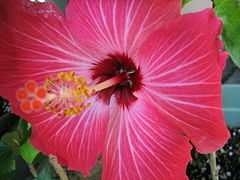
-

Hibiscus Brilliant
-
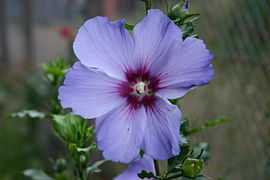
-
-
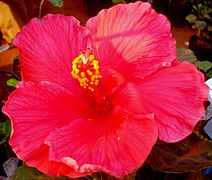
-
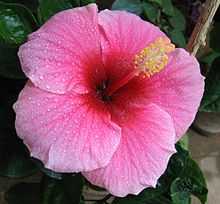
-
.jpg)
Hibiscus furcellatus
-
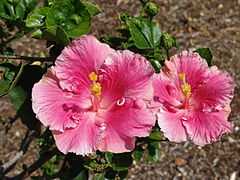
-
_(8058834522).jpg)
-

Hibiscus in Bhopal
-

At left, a flower emerges from a bud. At right, the same flower less than 18 hours later. -
Hibiscus splendens, a rainforest plant from eastern Australia. -
Hardy Giant Hibiscus
-

Hibiscus syriacus in Bensheim.
-
Red-layered hibiscus in Trivandrum
-
.jpg)
Hibiscus schizopetalus flower in Trivandrum, Kerala, India.
-

Tricolor hibiscus in Malaysia
-
Hibiscus from Kerala, India
-
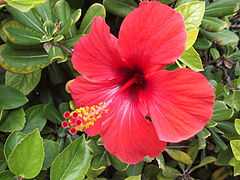
Red hibiscus in Alicante.
-

Red hibiscus : The National Flower of Malaysia
-
Hibiscus from Kerala, India
-
Hibiscus from Kerala, India
-

Pink hibiscus in Malaysia
-
Hibiscus from La Fortuna, Costa Rica
-

A hibiscus at the United States Botanic Garden located in Washington, D.C
References
- ↑ "Genus: Hibiscus L". Germplasm Resources Information Network. United States Department of Agriculture. 2007-10-05. Retrieved 2010-02-16.
- ↑ Oxford English Dictionary
- ↑ Sunset Western Garden Book, 1995:606–607
- ↑ Lawton, Barbara Perry (2004). Hibiscus: Hardy and Tropical Plants for the Garden. Timber Press. p. 36. ISBN 978-0-88192-654-5.
- ↑ Lee, David Webster (2007). Nature's Palette: the Science of Plant Color. University of Chicago Press. p. 183. ISBN 978-0-226-47052-8.
- ↑ Floridata: Plants That Attract Butterflies
- ↑ Nation's Restaurant News: Hibiscus blossoms as a food, drink ingredient
- ↑ Study Shows Consuming Hibiscus Tea Lowers Blood Pressure (accessed 05/10/2009)
- ↑ Ali BH, Al Wabel N & Blunden G. Phytochemical, pharmacological and toxicological aspects of Hibiscus sabdariffa L.: a review. Phytother Res.19(5): 369-375. (2005)
- ↑ D. Ojeda et al. Inhibition of angiotensin convertin enzyme (ACE) activity by the anthocyanins delphinidin- and cyaniding-3-O-sambubiosides from Hibiscus sabdariffa. Journal of Ethnopharmacology. 127: 7-10. (2010)
- ↑ A. Herrera-Arellano et al. Effectiveness and tolerability of a standardized extract from H. sabdariffa in patients with mild to moderate hypertension: a controlled and randomized clinical trial. Phytomedicine. 11: 375-382. (2004)
- ↑ M.Haji faraji & A.H. Haji Tarkhani. The effect of sour tea (Hibiscus sabdariffa) on essential hypertension. Journal of Ethnopharmacology. 65: 231-236. (1999)
- ↑ Plants for a Future: Hibiscus rosa-sinensis. (accessed 07/05/2009)
- ↑ Nevade Sidram A., Sachin G. Lokapure and N.V. Kalyane. 2011. Study on anti-solar activity of ehanolic extract of flower of Hibiscus rosa-sinensis Linn. Research Journal of Pharmacy and Technology 4(3): 472–473.
- ↑ http://www.poundoftea.com/benefits-of-hibiscus-flower-tea/
- ↑ C.C.Chen et al. Hibiscus sabdariffa Extract Inhibits the Development of Atherosclerosis in Cholesterol-Fed Rabbits. Journal of Agricultural and Food Chemistry. 51: 5472-5477. (2003)
- ↑ R. Mohamed et al. Roselle (Hibiscus sabdariffa) Seed Oil Is a Rich Source of γ–Tocopherol. Journal of Food Science. 72(3): 2007-211. (2007)
- ↑ 18.0 18.1 A.M.Fouda, M.Y.Daba & G.M. Dahab. Inhibitory effects of aqueous extracts of Hibiscus sabdariffa on contractility of the rat bladder and uterus. Can.J.Physiol.Pharmacol. 85:1020-1031. (2007)
- ↑ 19.0 19.1 N.Vasudeva & S.K.Sharma. Post-Coital Antifertility Activity of Hibiscus rosa-sinensis Linn.roots. Evid Based Complement Alternat Med. 5(1): 91-94. (2008)
- ↑ H.J.de Boer & C.Cotingting. Medicinal plants for women’s healthcare in Southeast Asia: a meta-analysis of their traditional use, chemical constituents, and pharmacology. J Ethnopharmacol. 151(2): 747-767. (2014)
- ↑ Ali BH, Al Wabel N & Blunden G. Phytochemical, pharmacological and toxicological aspects of Hibiscus sabdariffa L.: a review. Phytother Res.19(5): 369-375.(2005)
- ↑ 22.0 22.1 E.Ernst. Herbal medicinal products during pregnancy: are they safe? Br J Obstet Gynaecol. 109: 227-235. (2002)
- ↑ T.O. Fakeye et al. Effects of Water Extract of Hibiscus sabdariffa, Linn (Malvaceae) ‘Roselle’ on Excretion of a Diclofenac Formulation. Phytotherapy Research. 21: 96-98 (2007)
- ↑ B.M. Mahmoud et al. Significant reduction in chloroquine bioavailability following coadministration with the Sudanese beverages Aradaib, Karkadi and Lemon. Journal of Antimicrobial Chemotherapy. 33: 1005–1009 (1994)
- ↑ J.A.Kolawole & A.Maduenyi. Effect of Zobo drink (Hibiscus sabdariffa water extract) on the pharmacokinetics of acetaminophen in human volunteers. Eur J Drug Metab Pharmacokinet. 29(1): 25-29. (2004)
- ↑ Bussmann, R. W., et al. (2006). Plant use of the Maasai of Sekenani Valley, Maasai Mara, Kenya. J Ethnobiol Ethnomed 2 22.
- ↑ "GRIN Species Records of Hibiscus". Germplasm Resources Information Network. United States Department of Agriculture. Retrieved 2011-02-10.
External links
| Wikimedia Commons has media related to Hibiscus. |
| Wikispecies has information related to: Hibiscus |
- American Hibiscus Society (AHS)
- Australian Hibiscus Society
- International Hibiscus Society
- Foundation for Revitalisation of Local Health Traditions
- Dressler, S.; Schmidt, M. & Zizka, G. (2014). [http://www.africanplants.senckenberg.de/root/index.php?submitForm=true&page_id=77&searchTextMenue=Hibiscus&filterRegionIDs[]=6&filterRegionIDs[]=1&filterRegionIDs[]=2&filterRegionIDs[]=3&filterRegionIDs[]=5 "Hibiscus"]. African plants – a Photo Guide. Frankfurt/Main: Forschungsinstitut Senckenberg.













